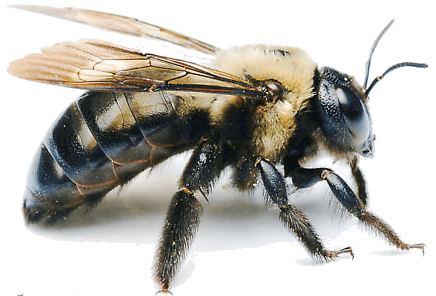
Carpenter Bees
Large, solitary wood-boring bees.
Facts & Information
Carpenter Bees
(Xylocopa)
19 to 25 millimeters long
Active Months:
April – September
Generally Not Aggressive
If Undisturbed
Insect Quantity:
1 – 5 per nest hole
Insect Color


Carpenter Bee Behavior:
Carpenter Bees can look like Bumble Bees; large, with yellow and black patterns. They are about one inch and may have some metallic reflections ranging from dark blue, yellow, green or purple tints. Their abdomens are shiny, which are different from Bumble Bees, which have more hair. They are commonly sighted in the spring hovering like a helicopter around eaves, porch rails, and under decks. Some times carpenter bees are called “wood bees”, because they bore into wood. Carpenter Bees do not eat the wood for nutrition. Carpenter bees, as pollinators eat nectar and pollen from flowering plants.
How Serious Are Carpenter Bees?
While fairly harmless, carpenter bees increase the number of nests over the course of years, causing noticeable damage to wood. They can also create stains with their feces.
Why call a professional to remove Carpenter Bees?
Calling a professional for carpenter bee removal is recommended due to several key reasons. Firstly, professionals possess the expertise and experience necessary to effectively address carpenter bee infestations. They understand the behavior and habits of these insects, enabling them to identify nesting sites accurately and implement targeted removal strategies. Additionally, professionals have access to specialized equipment and insecticides that are not readily available to the general public, ensuring thorough and safe eradication of carpenter bees without causing harm to humans or the environment. Moreover, relying on professionals can provide peace of mind, knowing that the infestation will be handled efficiently, and preventive measures can be implemented to reduce the risk of future occurrences, ultimately safeguarding the integrity of wooden structures on your property.
Not Sure What Type of Bees You Have?
If you see bees coming and going from an opening in your home, take a picture of the bees as well as the location where they are so we can positively identify the type of bees and text the pictures to 845-445-8273 or send us a bee removal request HERE.




Our Carpenter Bee Treatment Process:
At Rockland Bee Removal, our carpenter bee treatment process is thorough and effective, yet we cannot provide a guarantee due to the persistent nature of these insects. We begin with a meticulous inspection to locate carpenter bee activity and nesting sites on your property. Our skilled technicians then apply targeted treatments to eradicate existing infestations and deter future nesting. Despite our best efforts, carpenter bees may continue to be attracted to the wood on your property, potentially creating new entry holes and reusing existing ones. While we cannot guarantee complete eradication due to their living habits, we offer ongoing support and recommendations for preventive measures to minimize the risk of further infestation, providing you with peace of mind and protection for your property.
Call us 845-445-8273
Need Carpenter Bee Treatment at your location?
If you see bees hovering like a helicopter around eaves, porch rails, and under decks, take a picture of the bees as well as the location where they are so we can positively identify the type of bees and text the pictures to 845-445-8273 or send us a bee removal request HERE.


















